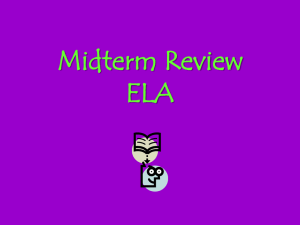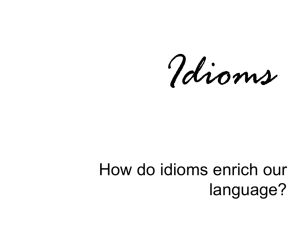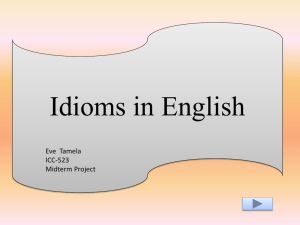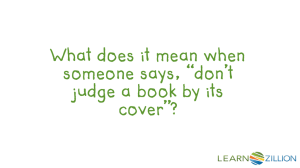Idiom
advertisement
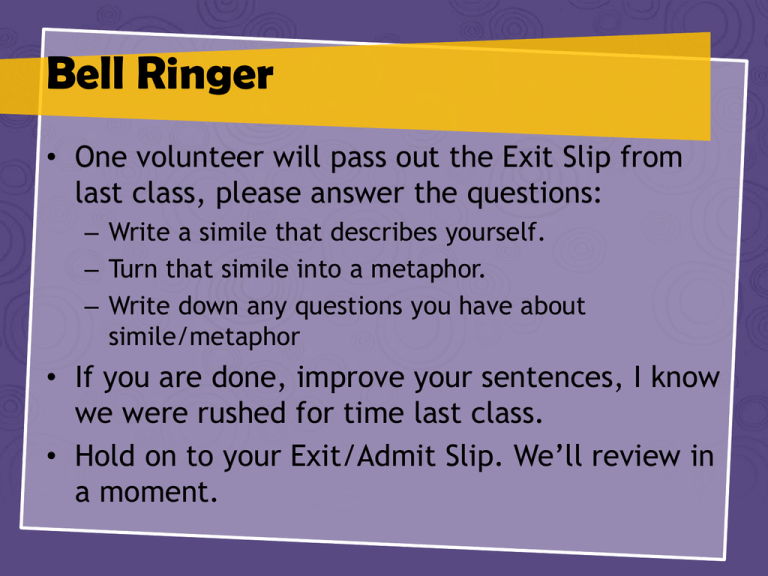
Bell Ringer • One volunteer will pass out the Exit Slip from last class, please answer the questions: – Write a simile that describes yourself. – Turn that simile into a metaphor. – Write down any questions you have about simile/metaphor • If you are done, improve your sentences, I know we were rushed for time last class. • Hold on to your Exit/Admit Slip. We’ll review in a moment. Housekeeping • Create Week 13 Word Relationship vocab. cards (in GREEN). The quiz will be after Winter Break and a specific date will be announced then. • Questions? • Paper Pass Back & short review Figurative Language Today’s Standards Sunshine State Standards LA.6.2.1.7 locate and analyze an author's use of allusions and descriptive, idiomatic, and figurative language in a variety of literary text, identifying how word choice sets the author's tone and advances the work's theme; I will be able to… •Determine the difference between figurative and literal meaning •Define idiom Today’s Learning Goals • Review the difference between literal and figurative language. • Learn what an idiom is by looking at examples we use everyday. Literal vs. Figurative “Do not add fuel to the fire.” • Just what is this sentence saying? • What fire? There’s no fire. Literal vs. Figurative “Do not add to the existing problem.” • What the writer really saying is don’t do something that will make the problem worse. • In this instance, “add to the existing problem” is the literal, or true, meaning. • Adding fuel to the fire is figurative language, also known as a figure of speech. Idiom Idiom Many idioms are very old and were once more literal in meaning. Close, but no cigar Bury the hatchet not quite good enough Making up after a fight be giventoasshow prizes in contests at fairs Native Americans Cigars used toused burytoweapons that and carnivals. player almost won, the person fighting had ended and enemiesWhen were anow at peace. running the game would say, “Close but no cigar.” Idiom Examples A B C D E F G H Add fuel to the fire Back to the drawing board Chip off the old block Down to the wire Elbow grease Fender bender Get over it Hop to it Idiom Examples I J K L M N O P Q It takes two to tango Jaywalk Know the ropes Let the cat out of the bag Mum’s the word No dice Off the hook Pay the piper Queen bee Idiom Examples R Raining cats and dogs S Sitting shotgun T Tie the knot U Under the weather V Velvet touch W Water under the bridge X X marks the spot Y Yank someone’s chain Z Zip your lip Idiom or Not? Idiom 1. Study hard--that’s our game plan. Idiom 2. We got off the beaten track. Metaphor 3. My legs were noodles after the race. Idiom 4. Bite your tongue. Personification 5. The empty page stared back at me. Idiom 6. My teacher let me off the hook. Simile 7. It’s like a cave in here. Idiom 8. Sorry, it was a knee jerk reaction. Let’s Play “Name That Idiom” • Look at the following pictures. • What idiom is depicted literally in each one? • What does the idiom mean? A knuckle sandwich refers to a punch in the face with a closed fist. Example: knuckle sandwich Name That Idiom! a bad egg someone who behaves in a bad or dishonest way Name That Idiom! has a frog in their throat someone whose sore throat makes it difficult to speak Name That Idiom! fighting tooth and nail someone willing do anything to win Name That Idiom! jack of all trades someone who can do many different jobs Name That Idiom! crying over spilled milk complaining about a problem after it is too late to correct it Name That Idiom! bed of roses a luxurious situation, easy life Name That Idiom! Get off your high horse. Stop acting as if you are better than other people. Name That Idiom! cool beans That is great. Individual Practice 1. Use an idiom in a complete sentence. 2. Underline the idiom. 3. Draw a picture of the literal meaning. It is raining cats and dogs. Gallery Walk 1. Place your illustrations on your desks. 2. Circulate around the room looking at each page. 3. Write down the understood meaning of each idiom you recognize. 4. We will share responses at the end.


